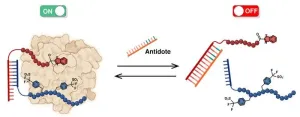(Press-News.org) Québec, April 30, 2024 - Cranberry extracts appear to improve intestinal microbiota and help prevent chronic diseases such as diabetes and cardiovascular diseases. The study of Université Laval and the Institute of Nutrition and Functional Foods (INAF) reported beneficial effects after only four days of use.
Cranberries and berries are associated with multiple health benefits, mainly attributed to their high content of polyphenols, in the form of tannins. They also contain high concentrations of oligosaccharides, small fibres that are thought to contribute to their bioactivity.
The research team, led by Yves Desjardins, professor at the Faculty of Agriculture and Food Sciences, showed that the polyphenols and oligosaccharides present in a cranberry extract boost the genus Bifidobacterium, associated with a reduced risk of diabetes and cardiometabolic diseases. “Normally, these bacteria are stimulated by dietary fibre consumption. We observed the same effect with cranberry extract with a dose almost 20 times lower," points out Jacob Lessard-Lord, a postdoctoral fellow at INAF.
Cranberry extracts also stimulate the Akkermansia muciniphila bacterium, which plays an important role in the intestinal mucosa, helping to reduce inflammation and strengthen the intestinal barrier.
This is of particular interest when it comes to countering the harmful effects of a Western diet. “This diet alters the microbiota, causes inflammation of the mucosa, and compromises the integrity of the intestinal barrier, which plays a crucial role in protecting the body from bacteria present in the gut. Alteration of the intestinal barrier allows the passage of lipopolysaccharides (LPS) derived from the intestinal microbiota, known as metabolic endotoxemia, and is a crucial factor in the onset and progression of inflammation and metabolic diseases,” explains Yves Desjardins.
“The constant inflammation that results from the presence of LPS in the body can lead to several chronic diseases, including diabetes, and cardiovascular disease,” he explains.
When included into a balanced diet, cranberry extracts could modify the inflammatory pathway and improve the prognosis of a chronic disease. By stimulating Akkermansia muciniphila bacterium and Bifidobacterium, the microbiota regenerates and recreates an anti-inflammatory environment. This results in strengthening the connections between the cells of the intestinal barrier, thereby fortifying it.
In the study, approximately forty participants recruited at INAF were instructed to consume a cranberry supplement in capsule form twice daily, morning and evening, which is equivalent to ingesting 60 grams of fresh cranberries. At the beginning of the experiment and after four days, samples of plasma, urine, and stool were collected from participants. The human study was initiated following promising results in the SHIME in vitro system, which reproduces regions of the intestine.
The research team is now interested in exploring the long-term effects of the extracts. "It's promising to see a beneficial effect after just four days," expresses Jacob Lessard-Lord with enthusiasm.
Although cranberries had a beneficial effect on all participants, the results highlighted variability in their responses. Future research will identify which microbiota signatures respond best to the extracts.
The study was conducted as part of the NSERC-Symrise Industrial Research Chair on the prebiotic effect of fruit and vegetable polyphenols (PhenoBio+). Symrise has launched a product based on the team's findings, Prebiocran, which has been approved in Europe.
The study was published in the scientific journal npj Biofilms & Microbiomes. The authors are Jacob Lessard-Lord, Charlène Roussel, Joseph Lupien-Meilleur, Pamela Généreux, Véronique Richard, Valérie Guay, Denis Roy and Yves Desjardins.
-30 -
Source :
Communications Department
Université Laval
418 656-3355
medias@ulaval.ca
END
Cranberry extracts could boost microbiota and counter cardiometabolic diseases
2024-04-30
ELSE PRESS RELEASES FROM THIS DATE:
Discovery of uranium-contaminated soil purification material without secondary environmental pollution
2024-04-30
Nuclear energy has long been regarded as a next-generation energy source, and major countries around the world are competing to secure cutting-edge technologies by leveraging the high economic efficiency and sustainability of nuclear power. However, uranium, which is essential for nuclear power generation, has serious implications for both soil ecosystems and human health. Despite being a key radioactive material, uranium poses significant health risks due to its chemical toxicity to the kidneys, bones, and cells. As a result, both the U.S. Environmental Protection Agency and the World Health Organization recommend allowing and advocating for uranium concentrations in wastewater ...
The carbon emissions of academic astronomy
2024-04-30
The carbon emissions associated with air travel to professional conferences make up a sizable fraction of the emissions produced by academia. Andrea Gokus and colleagues estimated the CO2-equivalent emissions for conference travel to all 362 open meetings in the field of astronomy in 2019. The total is an estimated 42,500 tCO2e, or about one ton per participant per meeting. According to the authors, networking and discussing new scientific developments at meetings is important for advancing the field, but adjustments can be made to reduce the hefty carbon cost. Holding meetings virtually ...
Journal of Pharmaceutical Analysis articles reveal the importance of phytocompounds and metabolomics analysis
2024-04-30
IBD is a common chronic gastrointestinal disorder and current treatment strategies can cause adverse effects. Thus, there is a need to identify alternative compounds to treat IBD. Similarly, the dose-related toxicity and efficacy of anticancer drugs needs to be monitored accurately to improve the treatment outcomes. Moreover, over the years, plant-based therapeutic compounds and traditional Chinese medicine formulas have gained attention for their enhanced healing effects and are promising for various treatment regimens.
The recent issue of the JPA, published ...
Great strides in the development of high refractive index polymers for optoelectronics
2024-04-30
Optoelectronic devices have found their way into many aspects of our daily lives, from OLED displays to photodetectors, security systems, and environmental monitoring. In all the applications, these devices utilize high refractive index polymers (HRIPs) to control light.
In general, the optical properties of transparent HRIPs enable efficient light transmission and manipulation, allowing optoelectronics devices to guide and control the flow of light to improve their performance. However, there are no low-cost options for HRIPs that can guarantee good optical performance while being transparent and environmentally ...
Engineered increase in mesophyll conductance improves photosynthetic efficiency in field trial
2024-04-30
It is possible to engineer increased mesophyll conductance in plants according to new research from the University of Illinois. Mesophyll conductance plays a key role in photosynthesis and refers to the ease with which CO2 can diffuse through a leaf’s cells before reaching the location where it is ultimately turned into sugar to feed the plant (carbon fixation). CO2 faces barriers as it moves through the leaf, including its own cell walls. Researchers from the Long Lab found that by increasing permeability and slightly reducing the thickness of cell walls, they could increase CO2 diffusion and uptake in a model crop.
“This is one of the ...
Unlocking the genetic mysteries behind plant adaptation: New insights into the evolution of a water-saving trait in the pineapple family (bromeliaceae)
2024-04-30
Researchers at the University of Vienna, along with collaborators from France, Germany, Switzerland and the USA, have achieved a major breakthrough in understanding how genetic drivers influence the evolution of a specific photosynthesis mechanism in Tillandsia (air plants). This sheds light on the complex actions that cause plant adaptation and ecological diversity. The results of their study are now published in Plant Cell.
Some plant species have evolved a water-saving trait called Crassulacean Acid Metabolism (CAM). CAM plants like most ...
Childcare pick-up: a 1-hour window to build healthier eating habits
2024-04-30
Millions of working parents know the routine: bustle the kids off to childcare in the morning, work all day, then fight the daily traffic jams to get the kids back home. Something to drink, maybe a snack to munch, can help ease the commute.
Understandably, few parents take the time to think about the nutrients or calories involved, but experts at Cincinnati Children’s decided to take a closer look. Their eyebrow-raising findings were published April 27, 2024, in the journal Children’s Health Care.
The researchers took a fresh look at older data contained in daily food journals kept by more than 300 families of children who attended 30 childcare ...
MD Anderson and Replay announce FDA clearance of IND application for first-in-class PRAME-targeted TCR NK cell therapy for hematological malignancies
2024-04-30
HOUSTON, SAN DIEGO and LONDON ― The University of Texas MD Anderson Cancer Center and Replay today announced that the Food & Drug Administration (FDA) has issued a ‘safe to proceed’ for the Investigational New Drug (IND) application for PRAME TCR/IL-15 NK (SY-307), an engineered T cell receptor natural killer (TCR NK) cell therapy for relapsed/refractory myeloid malignancies. MD Anderson is the IND sponsor.
PRAME TCR/IL-15 NK (SY-307) is being developed by Syena, an oncology-focused product company launched by Replay and MD Anderson based on the scientific discoveries of Katy ...
Discovery of mechanism plants use to change seed oil could impact industrial, food oils
2024-04-30
PULLMAN, Wash. -- Researchers have discovered a new mechanism of oil biosynthesis and found a way to genetically engineer a type of test plant to more efficiently produce different kinds of seed oil that it otherwise wouldn't make.
While the engineering is proof-of-concept, this discovery could lead to improved production of valuable oils used in food and by a range of industries. The study, led by Washington State University researchers, was published in the journal Nature Communications.
“Scientists have been working on producing ...
A new anticoagulant with no risk of bleeding
2024-04-30
Anticoagulant treatments are crucial for managing many conditions, such as heart disease, stroke and venous thrombosis. Current options, however, carry an inherent risk of serious bleeding due to trauma or unforeseen events. A team from the University of Geneva (UNIGE) and the University of Sydney has developed a new anticoagulant, designed to have an on-demand reversible activity, with a fast-acting ‘‘antidote’’. This approach could revolutionise the use of anticoagulants in surgery or other applications. The mechanism of activation and deactivation of the active principle ...







